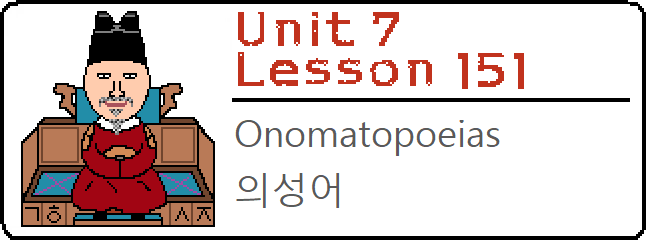Our first Workbook in Unit 7 is now available! Check it out here.
 Lesson 151: In this lesson, you will learn about Korean onomatopoeias and how to apply them to Korean sentences. The Korean language is filled with them. It would be too much to show you all Korean onomatopoeias. Instead, this lesson will present some common groups of onomatopoeias and give you example sentences for how they could be used. The intent of this lesson is for you to familiarize yourself with how Korean onomatopoeias are used so that when you come across one that you have never seen before, you can recognize it as such. Lesson 151: In this lesson, you will learn about Korean onomatopoeias and how to apply them to Korean sentences. The Korean language is filled with them. It would be too much to show you all Korean onomatopoeias. Instead, this lesson will present some common groups of onomatopoeias and give you example sentences for how they could be used. The intent of this lesson is for you to familiarize yourself with how Korean onomatopoeias are used so that when you come across one that you have never seen before, you can recognize it as such. |
 Lesson 152: The purpose of this lesson is to introduce you to trends I have noticed with mimetic words. It is hard to tell you exactly how a mimetic word works in Korean, because there are so many of them, and there are many ways that they can be used. The goal is for you to familiarize yourself with a bunch of mimetic words and how they are used, so that you can apply this knowledge the next time you come across a mimetic word in Korean. Lesson 152: The purpose of this lesson is to introduce you to trends I have noticed with mimetic words. It is hard to tell you exactly how a mimetic word works in Korean, because there are so many of them, and there are many ways that they can be used. The goal is for you to familiarize yourself with a bunch of mimetic words and how they are used, so that you can apply this knowledge the next time you come across a mimetic word in Korean. |
 Lesson 153: In this lesson, and the few lessons that follow, you will learn how to apply ~려 to create more complex meanings. In doing so, you will combine ~려 with some other grammatical principles. Lesson 153: In this lesson, and the few lessons that follow, you will learn how to apply ~려 to create more complex meanings. In doing so, you will combine ~려 with some other grammatical principles. |
 Lesson 154: In this lesson, you will continue to expand your understanding of ~려 by connecting it to another grammatical principle, ~다가. Lesson 154: In this lesson, you will continue to expand your understanding of ~려 by connecting it to another grammatical principle, ~다가. |

Lesson 155: In this lesson, you will continue to expand your understanding of ~(으)려 by connecting it to ~는 and ~던. |
 Lesson 156: In this lesson, you will continue to learn about grammatical principles that you can attach to ~(으)려, and how this can be used with the word 참. Lesson 156: In this lesson, you will continue to learn about grammatical principles that you can attach to ~(으)려, and how this can be used with the word 참. |
 Lesson 157: In this lesson, you will learn about a word that you can use in sentences to create complex meanings. This noun is quite flexible and can be used in a variety of situations. Let’s get started. Lesson 157: In this lesson, you will learn about a word that you can use in sentences to create complex meanings. This noun is quite flexible and can be used in a variety of situations. Let’s get started. |

